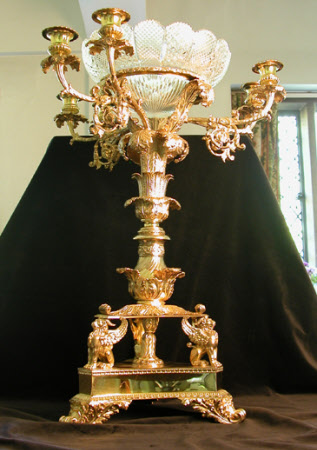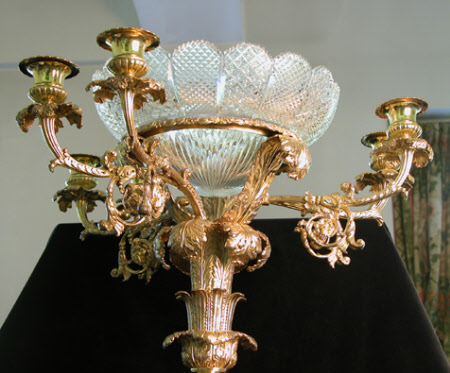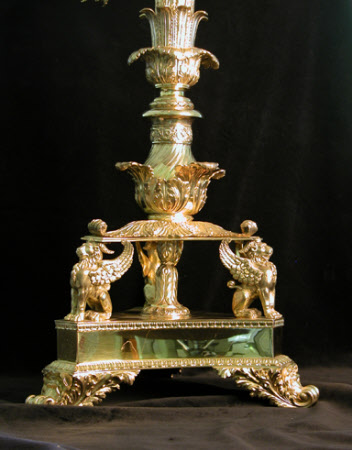Centrepiece
Rebecca Emes and Edward Barnard (fl.1808- 1829)
Category
Silver
Date
1818 - 1819
Materials
Silver
Measurements
49.9 x 26.8 x 30.8 cm; 5340 g (Weight)
Place of origin
England
Order this imageCollection
Anglesey Abbey, Cambridgeshire
NT 516439.1
Caption
Rebecca Emes was a partner in one of the largest manufacturing silversmiths of its day. Emes and Barnard’s London workshop created pieces for its own aristocratic customers and also supplied major retailers, including the prestigious royal goldsmiths Rundell, Bridge & Rundell. Following the death of her husband, John (1762–1808), like Louisa Courtauld and many other women before her, Emes took over his business. Her first mark was registered in 1808, jointly with William Emes, her husband’s executor, probably to ease the process of arranging John’s estate. A few months later she registered her first mark with her partner, Edward Barnard (d.1855), who was a reliable and known hand, having previously worked as foreman of the company for John. Together, they developed a highly successful business, supplying silver across Britain and overseas, including to the USA and India. The range of products the firm created was impressive and meant it could capitalise on a market of wealthy buyers hungry for gleaming silver to adorn their homes. It also shifted cannily as styles and habits evolved, introducing new patterns and forms in response to consumer demand. Emes and Barnard produced tea and coffee sets; dining accoutrements for the fashionable table, such as cruets, tureens and toast racks; and more personal practical items, such as inkstands and chamber candlesticks. The towering centrepiece at Anglesey Abbey – which appears to be lifted up on the backs of three winged lions – would have been a magnificent conversation piece at dessert, as well as providing light for those gathered around the table (and fruit to be taken from the bowl).
Summary
The stand and column for a massive centrepiece, silver-gilt (sterling), mark of Rebecca Emes & Edward Barnard, London, 1818/9. Three cast acanthus leaf capped scroll feet support the triangular stand with incurved sides and canted corners, made from sheet metal. The undecorated sides are applied at the base and cornice with borders of water leaves. Attached by shaped square screws to each corner of the flat stand is a finely modelled cast chimera with the body and head of a lion, eagle’s wings and goat’s horns. In the centre, standing on a circular foot with egg and dart border, is a waisted column of stylised leaves. A screw passes through the column to attach the first tier of vases. The lions and column support a triangular platform with incurved, low stepped sides. Over it, screwed on each corner, is a slightly domed platform chased all over with scrolling foliage, with scroll corners. In the centre, sitting on a laurel leaf wreath, is a cast calyx of four large everted acanthus leaves round a baluster-shaped knop chased with a matted spiral. Above it a border of scrolling foliage supports a compressed circular knop topped by a second laurel wreath. Screwed above is the second tier of vases, which commences with a hemi-spherical calyx-like bowl of everted acanthus leaves. It contains a slender trumpet-shaped vase of matted stiff leaves, which contains a second trumpet-shaped vase with sides rising to form six large scrolled acanthus leaves. Between the leaves is soldered a flat platform containing three sockets for the branches and a narrow circular threaded band, which screws to the support for the glass bowl. Solder to the support are three large scrolling acanthus leaves. At the top they are attached to a cast circular foliate band which holds the bowl. Heraldry: None
Full description
See Master Object entry for further information
Provenance
(Urban) Huttleston Rogers Broughton, 1st Baron Fairhaven (1896-1966) bequeathed by Lord Fairhaven to the National Trust along with the house and the rest of the contents National Trust
Credit line
Anglesey Abbey, the Fairhaven Collection (National Trust)
Marks and inscriptions
On the underside of the stand: Hallmarks: ‘‘RE’ over ‘EB’ (Rebecca Emes & Edward Barnard*), lion passant (sterling), leopard’s head (London), ‘c’ (1818/9), and monarch’s head (duty mark) *Arthur Grimwade: London Goldsmiths 1697-1837, 1990, p 166, no 2309 On the ring to hold the glass bowl: Hallmarks: ‘monarch’s head, lion passant and ‘c’ On the two lower platforms and the two tiers of vases: Hallmarks: these parts may be marked, but it was not possible to separate all the sections of the centrepiece. On the underside of the stand and on the surface of the platform to hold the branches: Old NT Inventory Number: AA/S/48 On the underside of the stand : Current NT Inventory Number: NT516439.1
Makers and roles
Rebecca Emes and Edward Barnard (fl.1808- 1829), goldsmith
References
Conroy, Rachel, Women Artists and Designers at the National Trust, 2025, pp. 98-99


